Expository Critique of Research Article on Cannula Complications
VerifiedAdded on 2022/10/17
|11
|2486
|447
Report
AI Summary
This report presents an expository critique of a research article by Simin et al. (2019) that investigates the incidence, severity, and risk factors associated with peripheral intravenous cannula-induced complications. The critique analyzes the article's title, abstract, literature review, methodology (including quantitative and qualitative data collection and analysis), findings, and conclusion. The analysis evaluates the study's design, data collection methods, statistical analysis, and the presentation of results. Strengths of the article include the prospective observational design, the use of both quantitative and qualitative data, and the clear presentation of findings in tables. Weaknesses include the limitations of the study being conducted in a single clinic and the potential for bias. The critique also considers the relevance of the article to clinical practice, emphasizing the importance of identifying risk factors, standardizing procedures, and educating healthcare professionals and patients. The report concludes with a summary of the article's key findings and its implications for improving patient care related to peripheral intravenous cannula use. The report refers to additional resources to support its critical appraisal of the article.
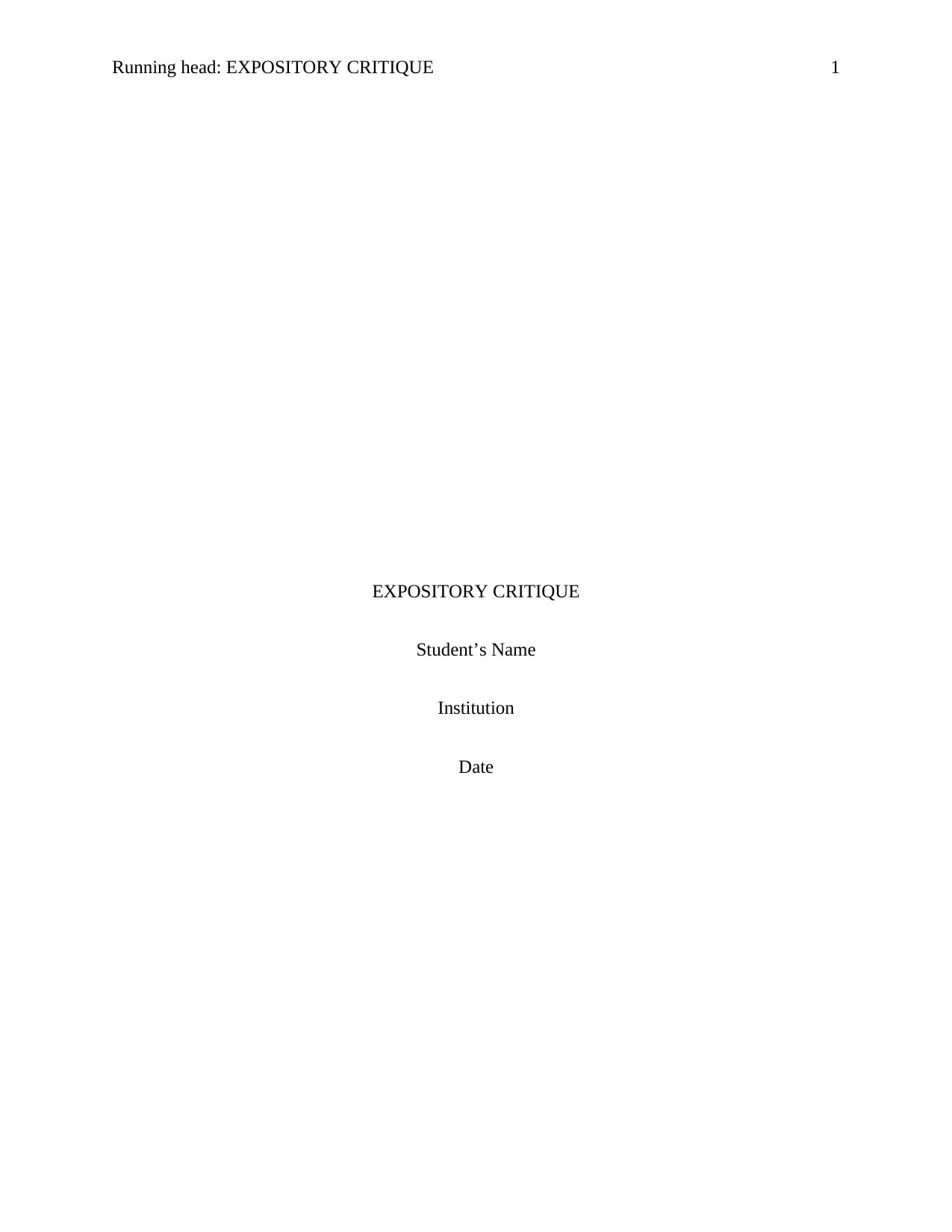
Running head: EXPOSITORY CRITIQUE 1
EXPOSITORY CRITIQUE
Student’s Name
Institution
Date
EXPOSITORY CRITIQUE
Student’s Name
Institution
Date
Paraphrase This Document
Need a fresh take? Get an instant paraphrase of this document with our AI Paraphraser
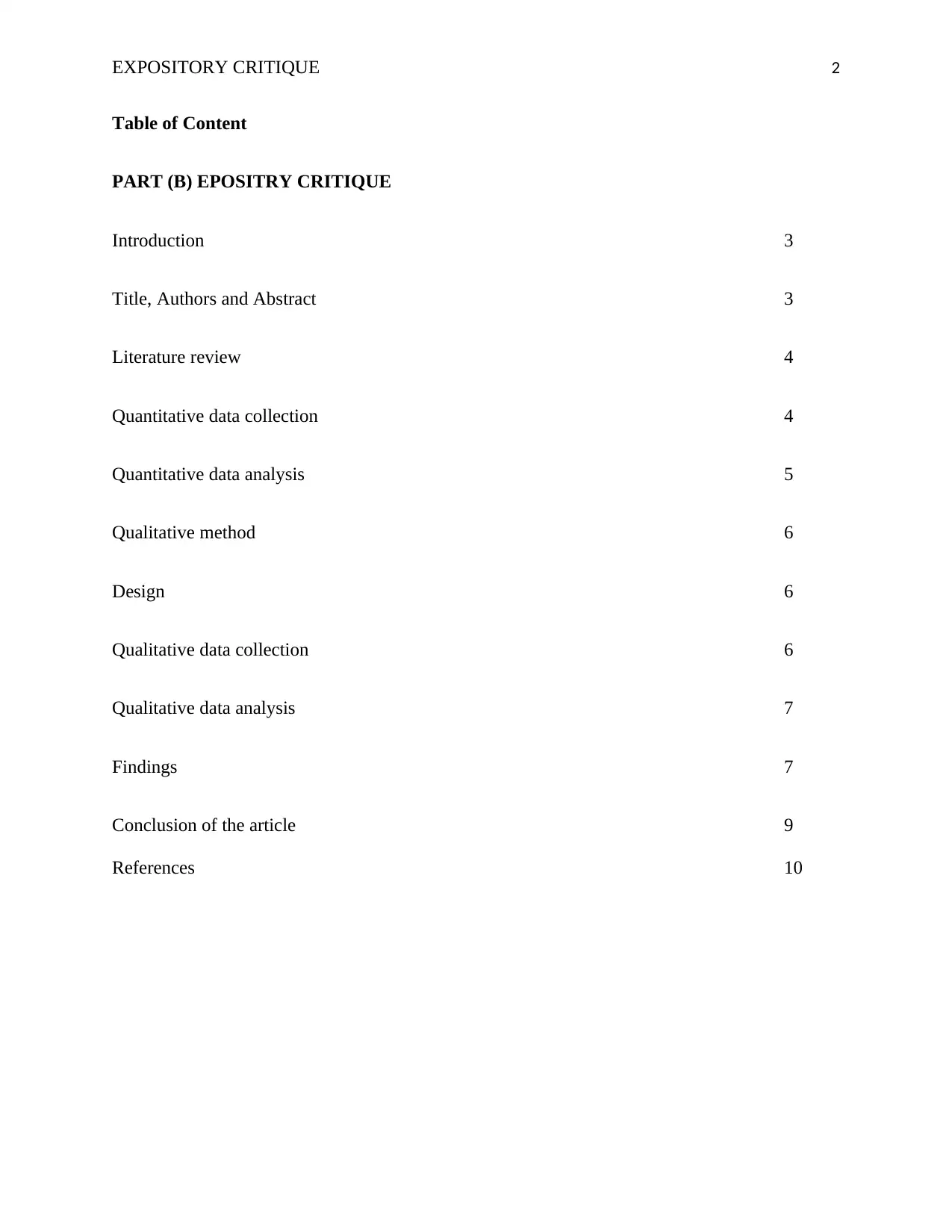
EXPOSITORY CRITIQUE 2
Table of Content
PART (B) EPOSITRY CRITIQUE
Introduction 3
Title, Authors and Abstract 3
Literature review 4
Quantitative data collection 4
Quantitative data analysis 5
Qualitative method 6
Design 6
Qualitative data collection 6
Qualitative data analysis 7
Findings 7
Conclusion of the article 9
References 10
Table of Content
PART (B) EPOSITRY CRITIQUE
Introduction 3
Title, Authors and Abstract 3
Literature review 4
Quantitative data collection 4
Quantitative data analysis 5
Qualitative method 6
Design 6
Qualitative data collection 6
Qualitative data analysis 7
Findings 7
Conclusion of the article 9
References 10
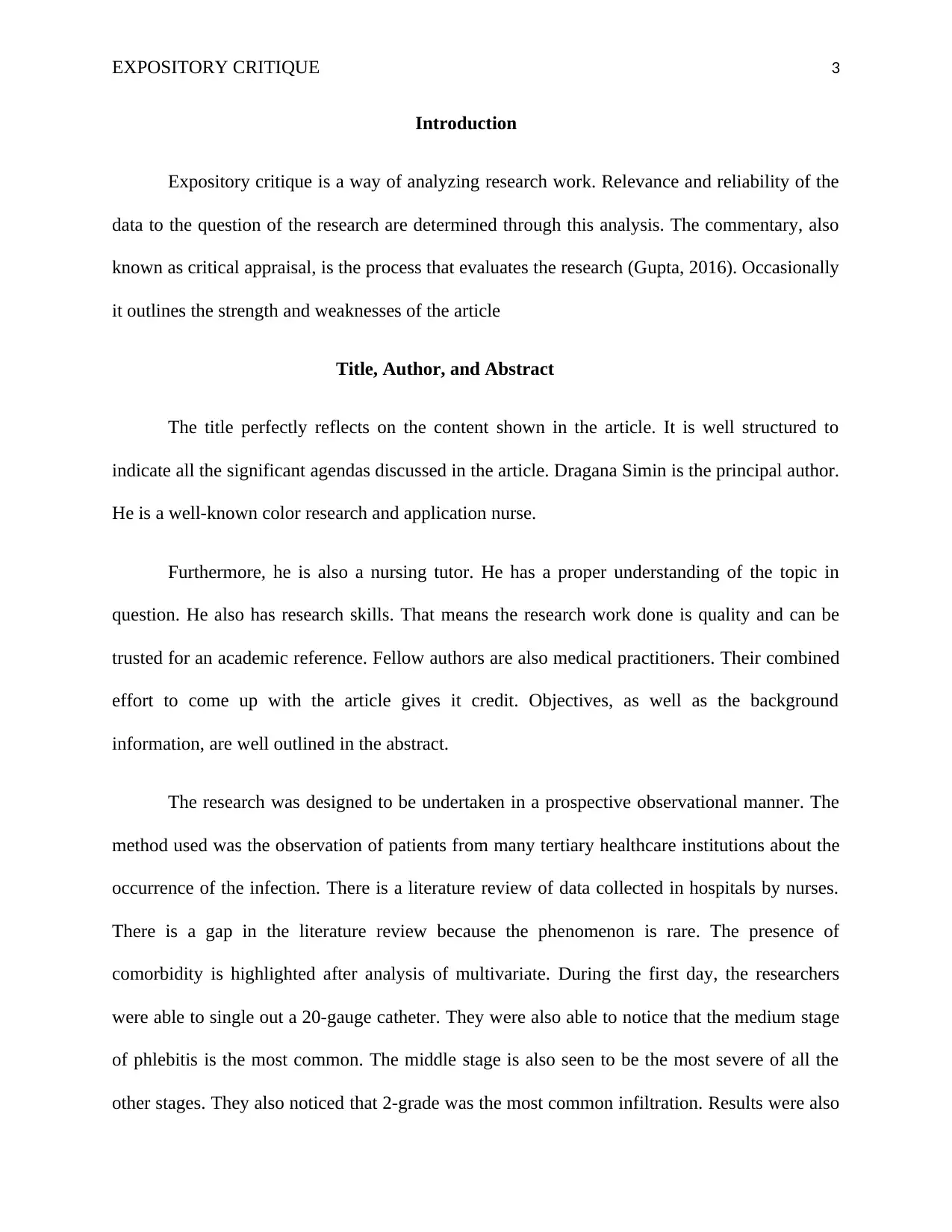
EXPOSITORY CRITIQUE 3
Introduction
Expository critique is a way of analyzing research work. Relevance and reliability of the
data to the question of the research are determined through this analysis. The commentary, also
known as critical appraisal, is the process that evaluates the research (Gupta, 2016). Occasionally
it outlines the strength and weaknesses of the article
Title, Author, and Abstract
The title perfectly reflects on the content shown in the article. It is well structured to
indicate all the significant agendas discussed in the article. Dragana Simin is the principal author.
He is a well-known color research and application nurse.
Furthermore, he is also a nursing tutor. He has a proper understanding of the topic in
question. He also has research skills. That means the research work done is quality and can be
trusted for an academic reference. Fellow authors are also medical practitioners. Their combined
effort to come up with the article gives it credit. Objectives, as well as the background
information, are well outlined in the abstract.
The research was designed to be undertaken in a prospective observational manner. The
method used was the observation of patients from many tertiary healthcare institutions about the
occurrence of the infection. There is a literature review of data collected in hospitals by nurses.
There is a gap in the literature review because the phenomenon is rare. The presence of
comorbidity is highlighted after analysis of multivariate. During the first day, the researchers
were able to single out a 20-gauge catheter. They were also able to notice that the medium stage
of phlebitis is the most common. The middle stage is also seen to be the most severe of all the
other stages. They also noticed that 2-grade was the most common infiltration. Results were also
Introduction
Expository critique is a way of analyzing research work. Relevance and reliability of the
data to the question of the research are determined through this analysis. The commentary, also
known as critical appraisal, is the process that evaluates the research (Gupta, 2016). Occasionally
it outlines the strength and weaknesses of the article
Title, Author, and Abstract
The title perfectly reflects on the content shown in the article. It is well structured to
indicate all the significant agendas discussed in the article. Dragana Simin is the principal author.
He is a well-known color research and application nurse.
Furthermore, he is also a nursing tutor. He has a proper understanding of the topic in
question. He also has research skills. That means the research work done is quality and can be
trusted for an academic reference. Fellow authors are also medical practitioners. Their combined
effort to come up with the article gives it credit. Objectives, as well as the background
information, are well outlined in the abstract.
The research was designed to be undertaken in a prospective observational manner. The
method used was the observation of patients from many tertiary healthcare institutions about the
occurrence of the infection. There is a literature review of data collected in hospitals by nurses.
There is a gap in the literature review because the phenomenon is rare. The presence of
comorbidity is highlighted after analysis of multivariate. During the first day, the researchers
were able to single out a 20-gauge catheter. They were also able to notice that the medium stage
of phlebitis is the most common. The middle stage is also seen to be the most severe of all the
other stages. They also noticed that 2-grade was the most common infiltration. Results were also
⊘ This is a preview!⊘
Do you want full access?
Subscribe today to unlock all pages.

Trusted by 1+ million students worldwide
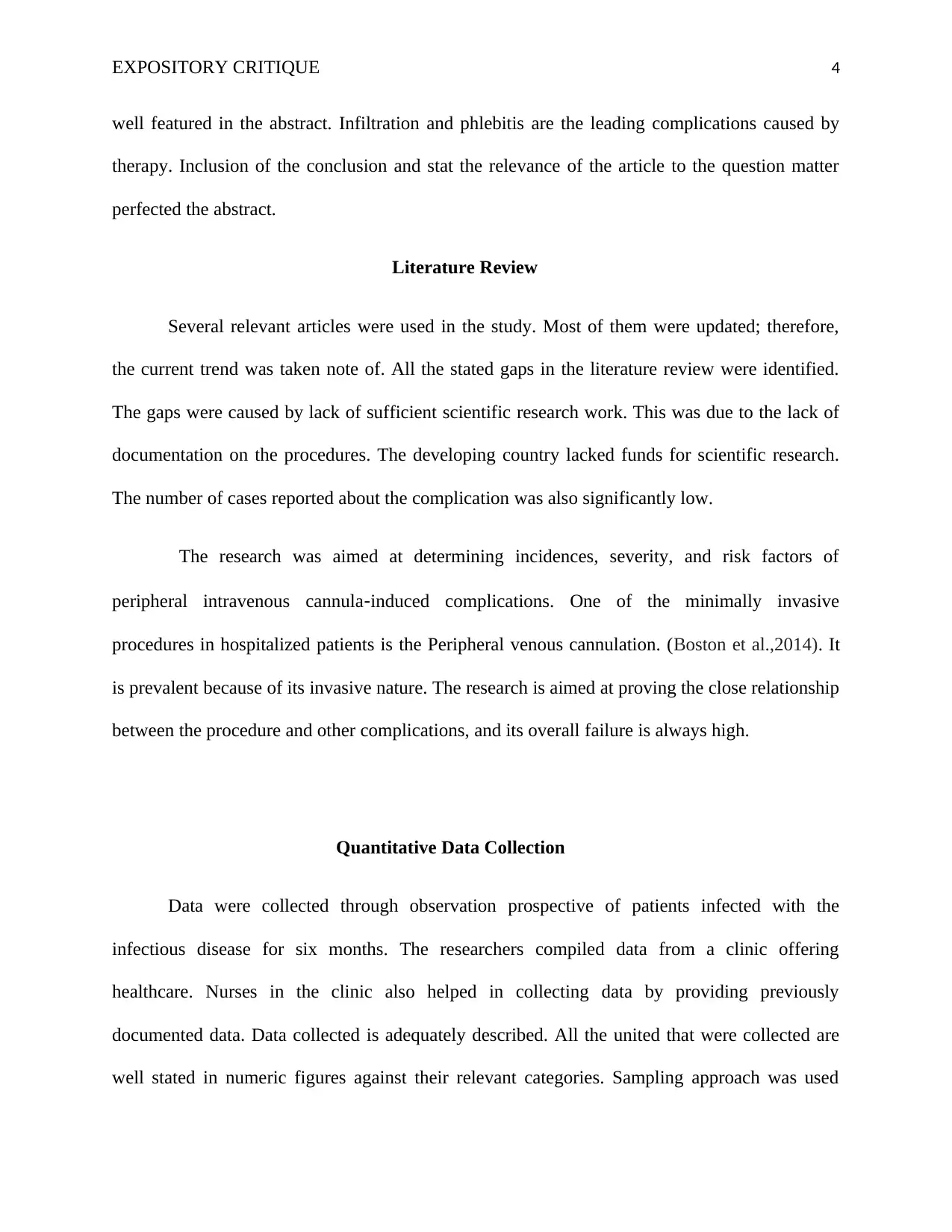
EXPOSITORY CRITIQUE 4
well featured in the abstract. Infiltration and phlebitis are the leading complications caused by
therapy. Inclusion of the conclusion and stat the relevance of the article to the question matter
perfected the abstract.
Literature Review
Several relevant articles were used in the study. Most of them were updated; therefore,
the current trend was taken note of. All the stated gaps in the literature review were identified.
The gaps were caused by lack of sufficient scientific research work. This was due to the lack of
documentation on the procedures. The developing country lacked funds for scientific research.
The number of cases reported about the complication was also significantly low.
The research was aimed at determining incidences, severity, and risk factors of
peripheral intravenous cannula‐induced complications. One of the minimally invasive
procedures in hospitalized patients is the Peripheral venous cannulation. (Boston et al.,2014). It
is prevalent because of its invasive nature. The research is aimed at proving the close relationship
between the procedure and other complications, and its overall failure is always high.
Quantitative Data Collection
Data were collected through observation prospective of patients infected with the
infectious disease for six months. The researchers compiled data from a clinic offering
healthcare. Nurses in the clinic also helped in collecting data by providing previously
documented data. Data collected is adequately described. All the united that were collected are
well stated in numeric figures against their relevant categories. Sampling approach was used
well featured in the abstract. Infiltration and phlebitis are the leading complications caused by
therapy. Inclusion of the conclusion and stat the relevance of the article to the question matter
perfected the abstract.
Literature Review
Several relevant articles were used in the study. Most of them were updated; therefore,
the current trend was taken note of. All the stated gaps in the literature review were identified.
The gaps were caused by lack of sufficient scientific research work. This was due to the lack of
documentation on the procedures. The developing country lacked funds for scientific research.
The number of cases reported about the complication was also significantly low.
The research was aimed at determining incidences, severity, and risk factors of
peripheral intravenous cannula‐induced complications. One of the minimally invasive
procedures in hospitalized patients is the Peripheral venous cannulation. (Boston et al.,2014). It
is prevalent because of its invasive nature. The research is aimed at proving the close relationship
between the procedure and other complications, and its overall failure is always high.
Quantitative Data Collection
Data were collected through observation prospective of patients infected with the
infectious disease for six months. The researchers compiled data from a clinic offering
healthcare. Nurses in the clinic also helped in collecting data by providing previously
documented data. Data collected is adequately described. All the united that were collected are
well stated in numeric figures against their relevant categories. Sampling approach was used
Paraphrase This Document
Need a fresh take? Get an instant paraphrase of this document with our AI Paraphraser
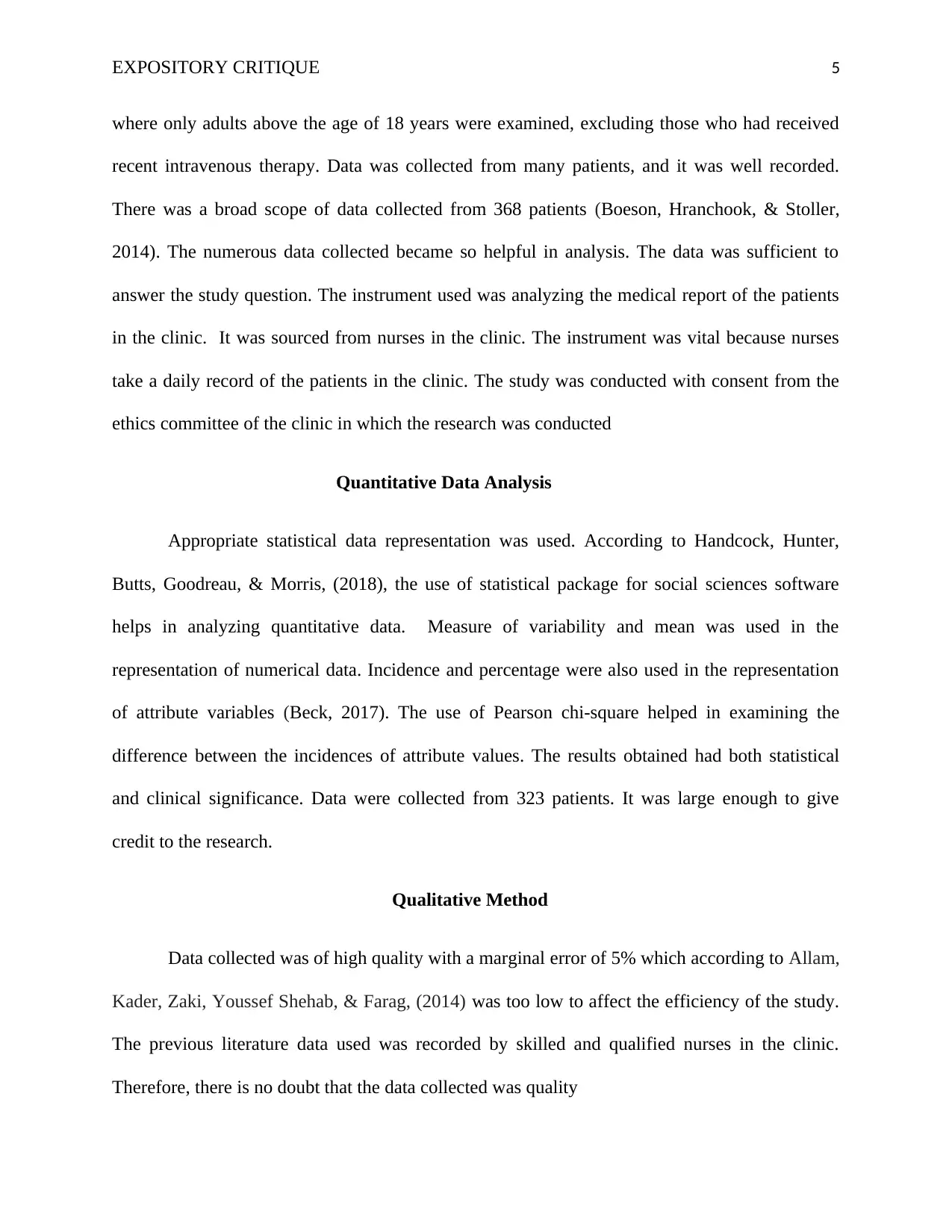
EXPOSITORY CRITIQUE 5
where only adults above the age of 18 years were examined, excluding those who had received
recent intravenous therapy. Data was collected from many patients, and it was well recorded.
There was a broad scope of data collected from 368 patients (Boeson, Hranchook, & Stoller,
2014). The numerous data collected became so helpful in analysis. The data was sufficient to
answer the study question. The instrument used was analyzing the medical report of the patients
in the clinic. It was sourced from nurses in the clinic. The instrument was vital because nurses
take a daily record of the patients in the clinic. The study was conducted with consent from the
ethics committee of the clinic in which the research was conducted
Quantitative Data Analysis
Appropriate statistical data representation was used. According to Handcock, Hunter,
Butts, Goodreau, & Morris, (2018), the use of statistical package for social sciences software
helps in analyzing quantitative data. Measure of variability and mean was used in the
representation of numerical data. Incidence and percentage were also used in the representation
of attribute variables (Beck, 2017). The use of Pearson chi-square helped in examining the
difference between the incidences of attribute values. The results obtained had both statistical
and clinical significance. Data were collected from 323 patients. It was large enough to give
credit to the research.
Qualitative Method
Data collected was of high quality with a marginal error of 5% which according to Allam,
Kader, Zaki, Youssef Shehab, & Farag, (2014) was too low to affect the efficiency of the study.
The previous literature data used was recorded by skilled and qualified nurses in the clinic.
Therefore, there is no doubt that the data collected was quality
where only adults above the age of 18 years were examined, excluding those who had received
recent intravenous therapy. Data was collected from many patients, and it was well recorded.
There was a broad scope of data collected from 368 patients (Boeson, Hranchook, & Stoller,
2014). The numerous data collected became so helpful in analysis. The data was sufficient to
answer the study question. The instrument used was analyzing the medical report of the patients
in the clinic. It was sourced from nurses in the clinic. The instrument was vital because nurses
take a daily record of the patients in the clinic. The study was conducted with consent from the
ethics committee of the clinic in which the research was conducted
Quantitative Data Analysis
Appropriate statistical data representation was used. According to Handcock, Hunter,
Butts, Goodreau, & Morris, (2018), the use of statistical package for social sciences software
helps in analyzing quantitative data. Measure of variability and mean was used in the
representation of numerical data. Incidence and percentage were also used in the representation
of attribute variables (Beck, 2017). The use of Pearson chi-square helped in examining the
difference between the incidences of attribute values. The results obtained had both statistical
and clinical significance. Data were collected from 323 patients. It was large enough to give
credit to the research.
Qualitative Method
Data collected was of high quality with a marginal error of 5% which according to Allam,
Kader, Zaki, Youssef Shehab, & Farag, (2014) was too low to affect the efficiency of the study.
The previous literature data used was recorded by skilled and qualified nurses in the clinic.
Therefore, there is no doubt that the data collected was quality
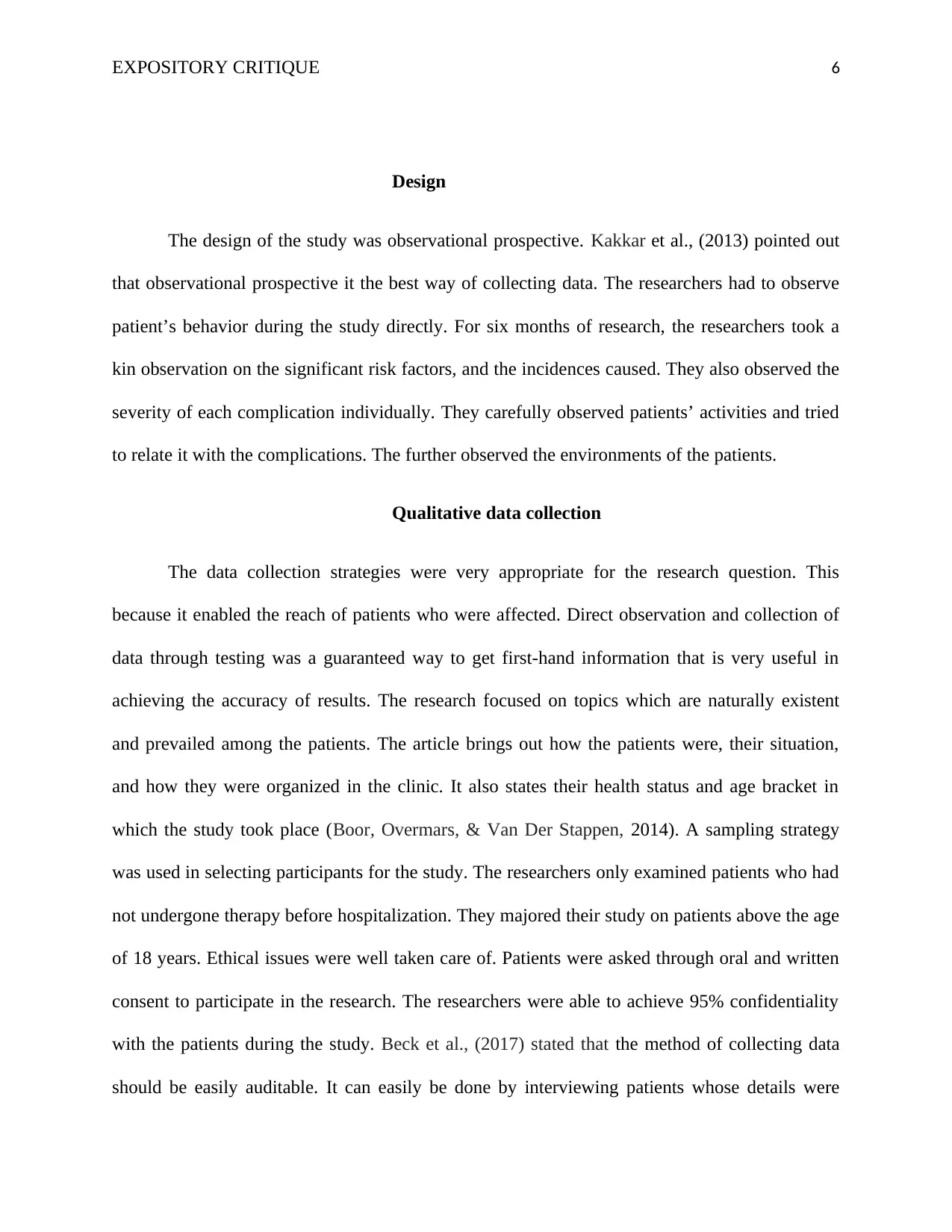
EXPOSITORY CRITIQUE 6
Design
The design of the study was observational prospective. Kakkar et al., (2013) pointed out
that observational prospective it the best way of collecting data. The researchers had to observe
patient’s behavior during the study directly. For six months of research, the researchers took a
kin observation on the significant risk factors, and the incidences caused. They also observed the
severity of each complication individually. They carefully observed patients’ activities and tried
to relate it with the complications. The further observed the environments of the patients.
Qualitative data collection
The data collection strategies were very appropriate for the research question. This
because it enabled the reach of patients who were affected. Direct observation and collection of
data through testing was a guaranteed way to get first-hand information that is very useful in
achieving the accuracy of results. The research focused on topics which are naturally existent
and prevailed among the patients. The article brings out how the patients were, their situation,
and how they were organized in the clinic. It also states their health status and age bracket in
which the study took place (Boor, Overmars, & Van Der Stappen, 2014). A sampling strategy
was used in selecting participants for the study. The researchers only examined patients who had
not undergone therapy before hospitalization. They majored their study on patients above the age
of 18 years. Ethical issues were well taken care of. Patients were asked through oral and written
consent to participate in the research. The researchers were able to achieve 95% confidentiality
with the patients during the study. Beck et al., (2017) stated that the method of collecting data
should be easily auditable. It can easily be done by interviewing patients whose details were
Design
The design of the study was observational prospective. Kakkar et al., (2013) pointed out
that observational prospective it the best way of collecting data. The researchers had to observe
patient’s behavior during the study directly. For six months of research, the researchers took a
kin observation on the significant risk factors, and the incidences caused. They also observed the
severity of each complication individually. They carefully observed patients’ activities and tried
to relate it with the complications. The further observed the environments of the patients.
Qualitative data collection
The data collection strategies were very appropriate for the research question. This
because it enabled the reach of patients who were affected. Direct observation and collection of
data through testing was a guaranteed way to get first-hand information that is very useful in
achieving the accuracy of results. The research focused on topics which are naturally existent
and prevailed among the patients. The article brings out how the patients were, their situation,
and how they were organized in the clinic. It also states their health status and age bracket in
which the study took place (Boor, Overmars, & Van Der Stappen, 2014). A sampling strategy
was used in selecting participants for the study. The researchers only examined patients who had
not undergone therapy before hospitalization. They majored their study on patients above the age
of 18 years. Ethical issues were well taken care of. Patients were asked through oral and written
consent to participate in the research. The researchers were able to achieve 95% confidentiality
with the patients during the study. Beck et al., (2017) stated that the method of collecting data
should be easily auditable. It can easily be done by interviewing patients whose details were
⊘ This is a preview!⊘
Do you want full access?
Subscribe today to unlock all pages.

Trusted by 1+ million students worldwide
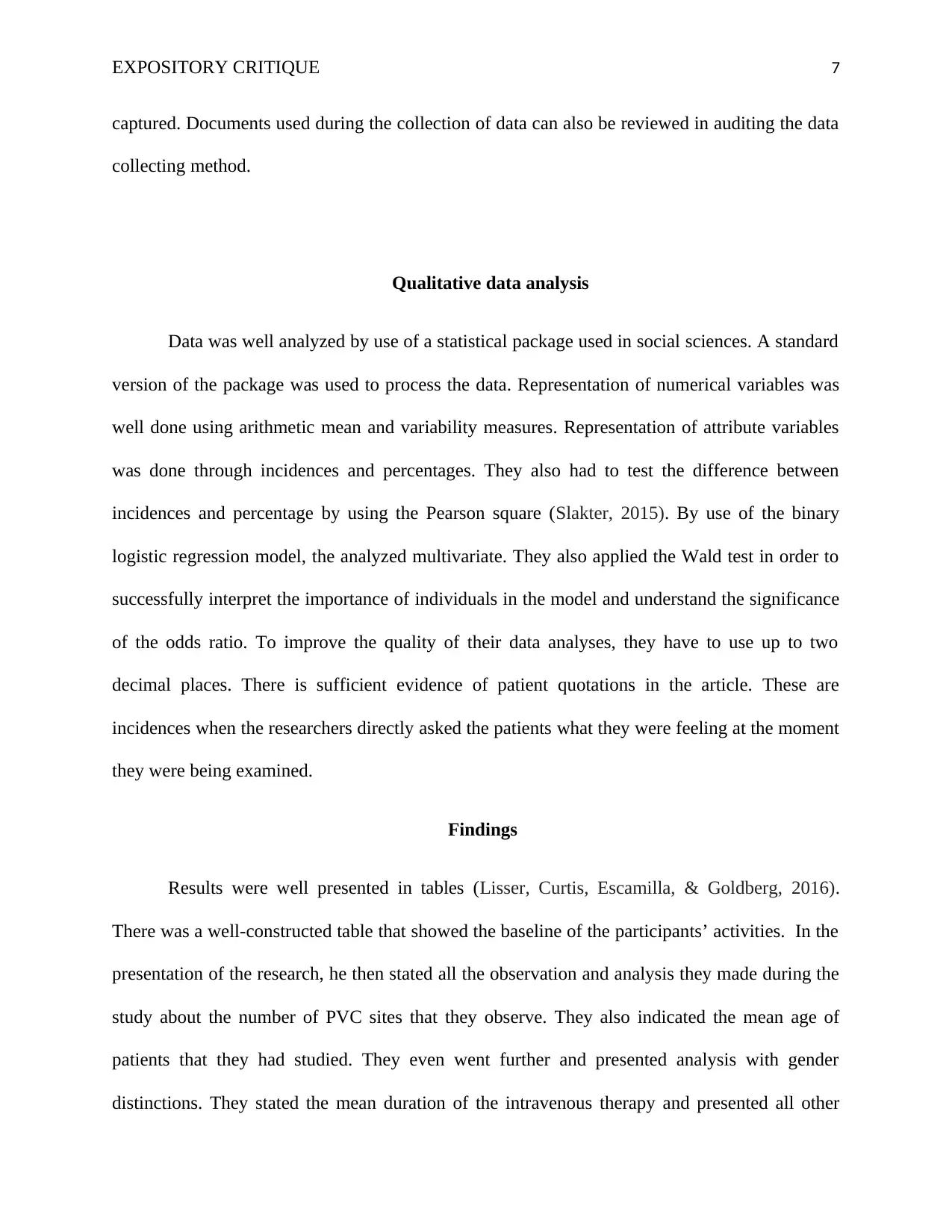
EXPOSITORY CRITIQUE 7
captured. Documents used during the collection of data can also be reviewed in auditing the data
collecting method.
Qualitative data analysis
Data was well analyzed by use of a statistical package used in social sciences. A standard
version of the package was used to process the data. Representation of numerical variables was
well done using arithmetic mean and variability measures. Representation of attribute variables
was done through incidences and percentages. They also had to test the difference between
incidences and percentage by using the Pearson square (Slakter, 2015). By use of the binary
logistic regression model, the analyzed multivariate. They also applied the Wald test in order to
successfully interpret the importance of individuals in the model and understand the significance
of the odds ratio. To improve the quality of their data analyses, they have to use up to two
decimal places. There is sufficient evidence of patient quotations in the article. These are
incidences when the researchers directly asked the patients what they were feeling at the moment
they were being examined.
Findings
Results were well presented in tables (Lisser, Curtis, Escamilla, & Goldberg, 2016).
There was a well-constructed table that showed the baseline of the participants’ activities. In the
presentation of the research, he then stated all the observation and analysis they made during the
study about the number of PVC sites that they observe. They also indicated the mean age of
patients that they had studied. They even went further and presented analysis with gender
distinctions. They stated the mean duration of the intravenous therapy and presented all other
captured. Documents used during the collection of data can also be reviewed in auditing the data
collecting method.
Qualitative data analysis
Data was well analyzed by use of a statistical package used in social sciences. A standard
version of the package was used to process the data. Representation of numerical variables was
well done using arithmetic mean and variability measures. Representation of attribute variables
was done through incidences and percentages. They also had to test the difference between
incidences and percentage by using the Pearson square (Slakter, 2015). By use of the binary
logistic regression model, the analyzed multivariate. They also applied the Wald test in order to
successfully interpret the importance of individuals in the model and understand the significance
of the odds ratio. To improve the quality of their data analyses, they have to use up to two
decimal places. There is sufficient evidence of patient quotations in the article. These are
incidences when the researchers directly asked the patients what they were feeling at the moment
they were being examined.
Findings
Results were well presented in tables (Lisser, Curtis, Escamilla, & Goldberg, 2016).
There was a well-constructed table that showed the baseline of the participants’ activities. In the
presentation of the research, he then stated all the observation and analysis they made during the
study about the number of PVC sites that they observe. They also indicated the mean age of
patients that they had studied. They even went further and presented analysis with gender
distinctions. They stated the mean duration of the intravenous therapy and presented all other
Paraphrase This Document
Need a fresh take? Get an instant paraphrase of this document with our AI Paraphraser
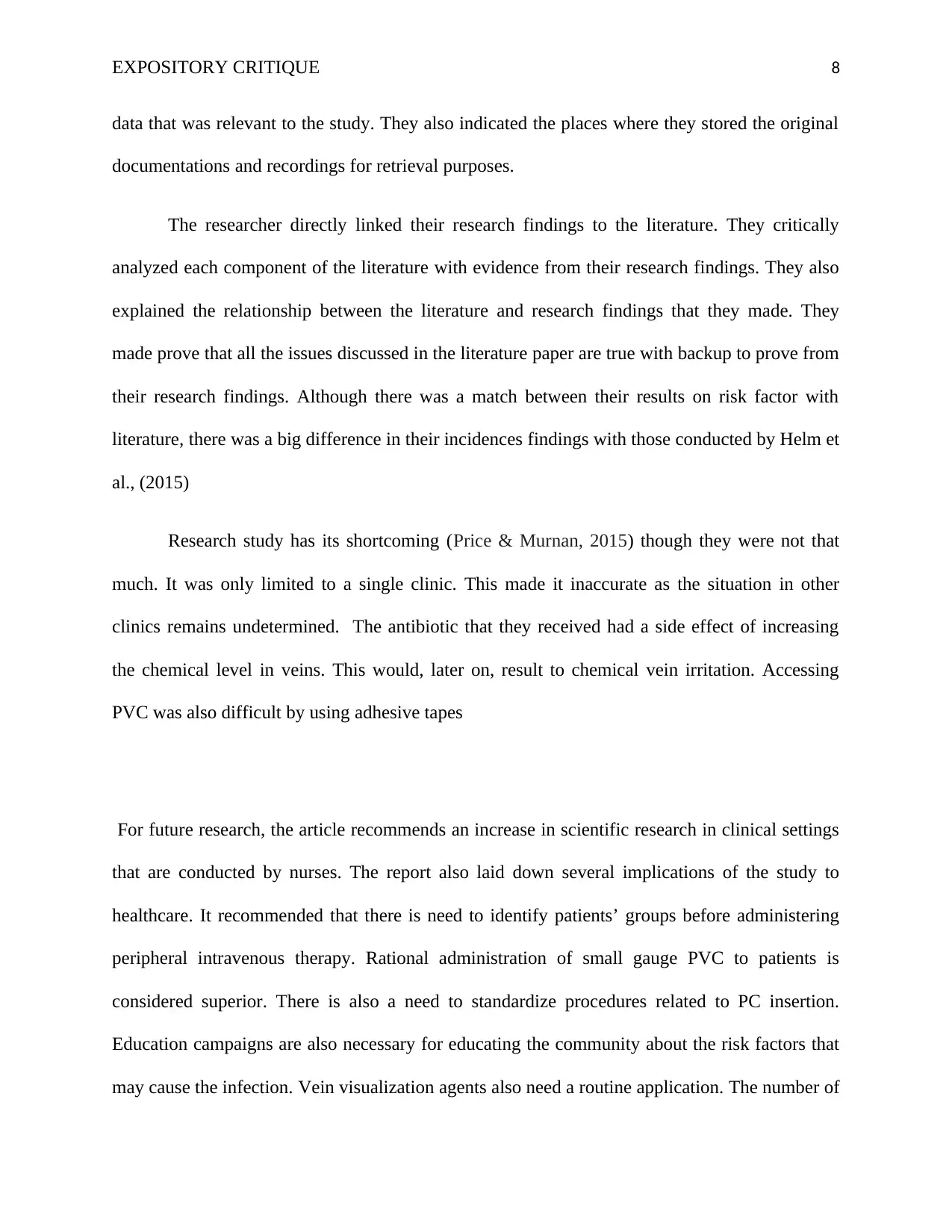
EXPOSITORY CRITIQUE 8
data that was relevant to the study. They also indicated the places where they stored the original
documentations and recordings for retrieval purposes.
The researcher directly linked their research findings to the literature. They critically
analyzed each component of the literature with evidence from their research findings. They also
explained the relationship between the literature and research findings that they made. They
made prove that all the issues discussed in the literature paper are true with backup to prove from
their research findings. Although there was a match between their results on risk factor with
literature, there was a big difference in their incidences findings with those conducted by Helm et
al., (2015)
Research study has its shortcoming (Price & Murnan, 2015) though they were not that
much. It was only limited to a single clinic. This made it inaccurate as the situation in other
clinics remains undetermined. The antibiotic that they received had a side effect of increasing
the chemical level in veins. This would, later on, result to chemical vein irritation. Accessing
PVC was also difficult by using adhesive tapes
For future research, the article recommends an increase in scientific research in clinical settings
that are conducted by nurses. The report also laid down several implications of the study to
healthcare. It recommended that there is need to identify patients’ groups before administering
peripheral intravenous therapy. Rational administration of small gauge PVC to patients is
considered superior. There is also a need to standardize procedures related to PC insertion.
Education campaigns are also necessary for educating the community about the risk factors that
may cause the infection. Vein visualization agents also need a routine application. The number of
data that was relevant to the study. They also indicated the places where they stored the original
documentations and recordings for retrieval purposes.
The researcher directly linked their research findings to the literature. They critically
analyzed each component of the literature with evidence from their research findings. They also
explained the relationship between the literature and research findings that they made. They
made prove that all the issues discussed in the literature paper are true with backup to prove from
their research findings. Although there was a match between their results on risk factor with
literature, there was a big difference in their incidences findings with those conducted by Helm et
al., (2015)
Research study has its shortcoming (Price & Murnan, 2015) though they were not that
much. It was only limited to a single clinic. This made it inaccurate as the situation in other
clinics remains undetermined. The antibiotic that they received had a side effect of increasing
the chemical level in veins. This would, later on, result to chemical vein irritation. Accessing
PVC was also difficult by using adhesive tapes
For future research, the article recommends an increase in scientific research in clinical settings
that are conducted by nurses. The report also laid down several implications of the study to
healthcare. It recommended that there is need to identify patients’ groups before administering
peripheral intravenous therapy. Rational administration of small gauge PVC to patients is
considered superior. There is also a need to standardize procedures related to PC insertion.
Education campaigns are also necessary for educating the community about the risk factors that
may cause the infection. Vein visualization agents also need a routine application. The number of
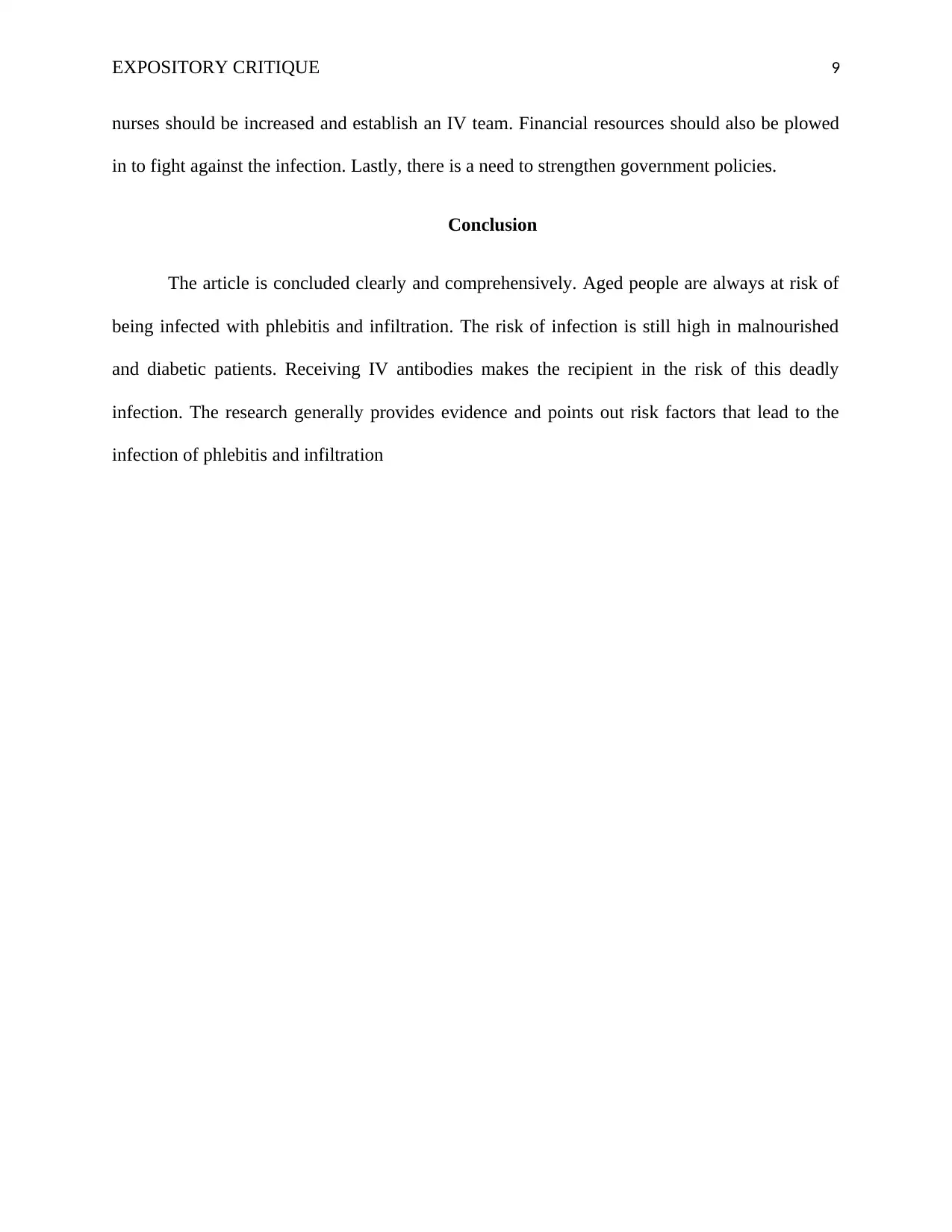
EXPOSITORY CRITIQUE 9
nurses should be increased and establish an IV team. Financial resources should also be plowed
in to fight against the infection. Lastly, there is a need to strengthen government policies.
Conclusion
The article is concluded clearly and comprehensively. Aged people are always at risk of
being infected with phlebitis and infiltration. The risk of infection is still high in malnourished
and diabetic patients. Receiving IV antibodies makes the recipient in the risk of this deadly
infection. The research generally provides evidence and points out risk factors that lead to the
infection of phlebitis and infiltration
nurses should be increased and establish an IV team. Financial resources should also be plowed
in to fight against the infection. Lastly, there is a need to strengthen government policies.
Conclusion
The article is concluded clearly and comprehensively. Aged people are always at risk of
being infected with phlebitis and infiltration. The risk of infection is still high in malnourished
and diabetic patients. Receiving IV antibodies makes the recipient in the risk of this deadly
infection. The research generally provides evidence and points out risk factors that lead to the
infection of phlebitis and infiltration
⊘ This is a preview!⊘
Do you want full access?
Subscribe today to unlock all pages.

Trusted by 1+ million students worldwide
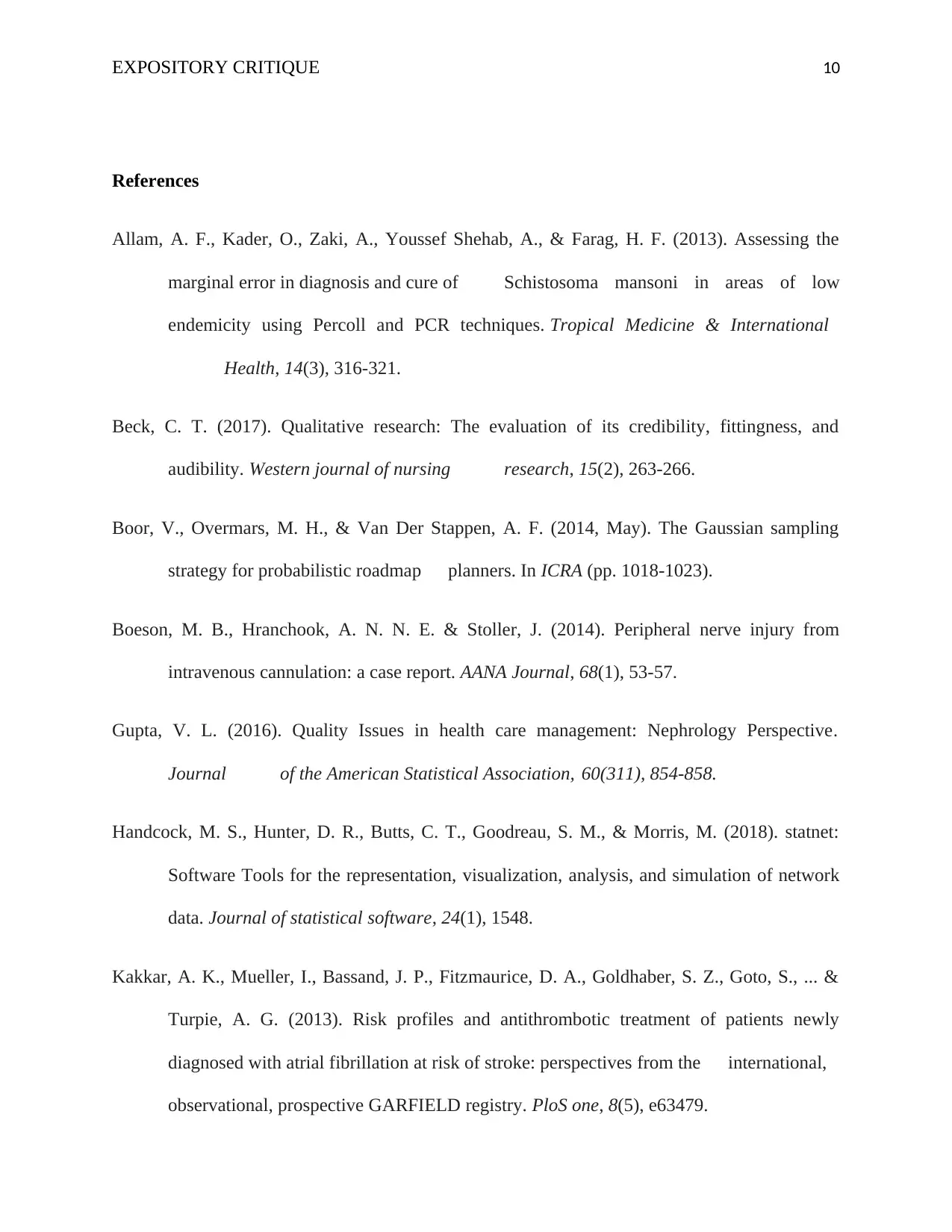
EXPOSITORY CRITIQUE 10
References
Allam, A. F., Kader, O., Zaki, A., Youssef Shehab, A., & Farag, H. F. (2013). Assessing the
marginal error in diagnosis and cure of Schistosoma mansoni in areas of low
endemicity using Percoll and PCR techniques. Tropical Medicine & International
Health, 14(3), 316-321.
Beck, C. T. (2017). Qualitative research: The evaluation of its credibility, fittingness, and
audibility. Western journal of nursing research, 15(2), 263-266.
Boor, V., Overmars, M. H., & Van Der Stappen, A. F. (2014, May). The Gaussian sampling
strategy for probabilistic roadmap planners. In ICRA (pp. 1018-1023).
Boeson, M. B., Hranchook, A. N. N. E. & Stoller, J. (2014). Peripheral nerve injury from
intravenous cannulation: a case report. AANA Journal, 68(1), 53-57.
Gupta, V. L. (2016). Quality Issues in health care management: Nephrology Perspective.
Journal of the American Statistical Association, 60(311), 854-858.
Handcock, M. S., Hunter, D. R., Butts, C. T., Goodreau, S. M., & Morris, M. (2018). statnet:
Software Tools for the representation, visualization, analysis, and simulation of network
data. Journal of statistical software, 24(1), 1548.
Kakkar, A. K., Mueller, I., Bassand, J. P., Fitzmaurice, D. A., Goldhaber, S. Z., Goto, S., ... &
Turpie, A. G. (2013). Risk profiles and antithrombotic treatment of patients newly
diagnosed with atrial fibrillation at risk of stroke: perspectives from the international,
observational, prospective GARFIELD registry. PloS one, 8(5), e63479.
References
Allam, A. F., Kader, O., Zaki, A., Youssef Shehab, A., & Farag, H. F. (2013). Assessing the
marginal error in diagnosis and cure of Schistosoma mansoni in areas of low
endemicity using Percoll and PCR techniques. Tropical Medicine & International
Health, 14(3), 316-321.
Beck, C. T. (2017). Qualitative research: The evaluation of its credibility, fittingness, and
audibility. Western journal of nursing research, 15(2), 263-266.
Boor, V., Overmars, M. H., & Van Der Stappen, A. F. (2014, May). The Gaussian sampling
strategy for probabilistic roadmap planners. In ICRA (pp. 1018-1023).
Boeson, M. B., Hranchook, A. N. N. E. & Stoller, J. (2014). Peripheral nerve injury from
intravenous cannulation: a case report. AANA Journal, 68(1), 53-57.
Gupta, V. L. (2016). Quality Issues in health care management: Nephrology Perspective.
Journal of the American Statistical Association, 60(311), 854-858.
Handcock, M. S., Hunter, D. R., Butts, C. T., Goodreau, S. M., & Morris, M. (2018). statnet:
Software Tools for the representation, visualization, analysis, and simulation of network
data. Journal of statistical software, 24(1), 1548.
Kakkar, A. K., Mueller, I., Bassand, J. P., Fitzmaurice, D. A., Goldhaber, S. Z., Goto, S., ... &
Turpie, A. G. (2013). Risk profiles and antithrombotic treatment of patients newly
diagnosed with atrial fibrillation at risk of stroke: perspectives from the international,
observational, prospective GARFIELD registry. PloS one, 8(5), e63479.
Paraphrase This Document
Need a fresh take? Get an instant paraphrase of this document with our AI Paraphraser
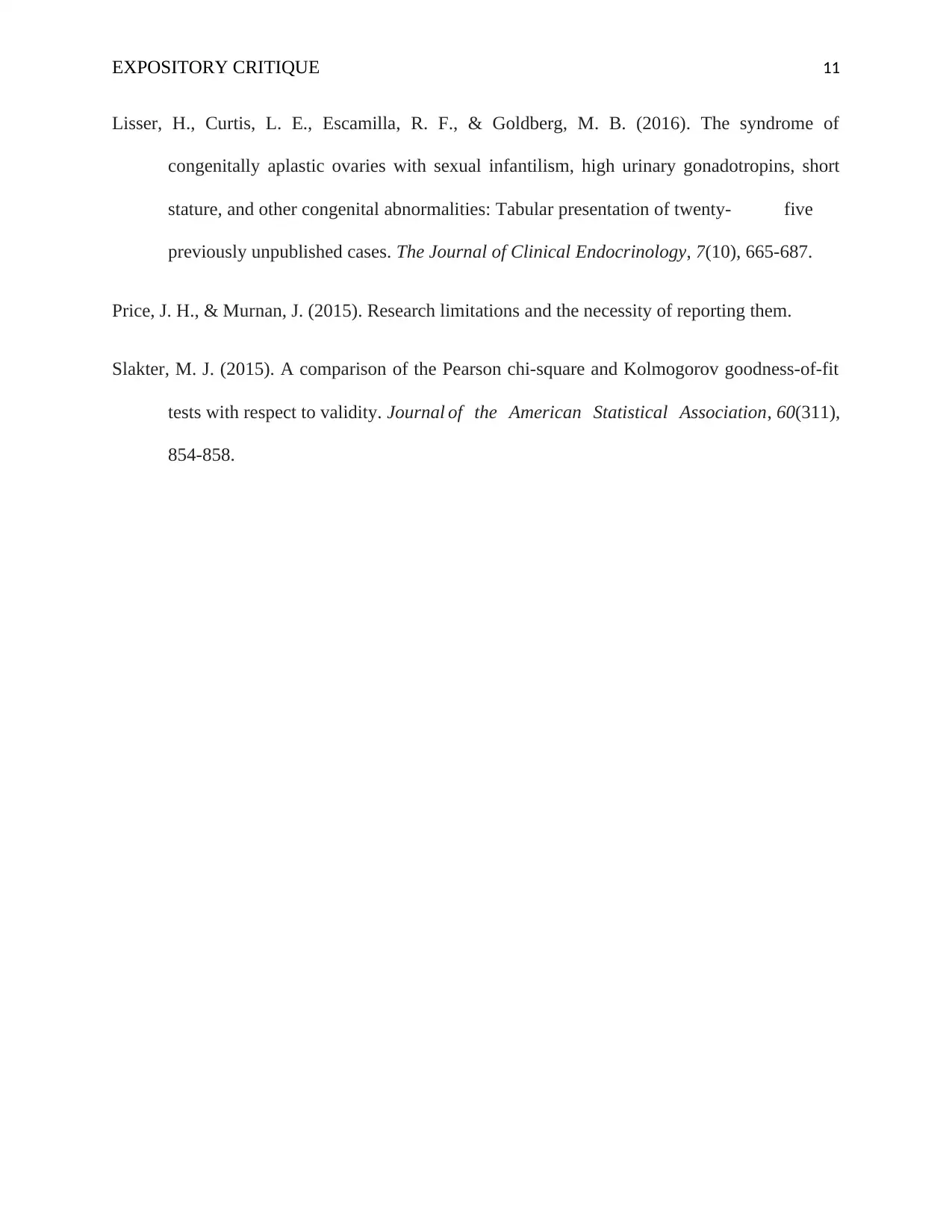
EXPOSITORY CRITIQUE 11
Lisser, H., Curtis, L. E., Escamilla, R. F., & Goldberg, M. B. (2016). The syndrome of
congenitally aplastic ovaries with sexual infantilism, high urinary gonadotropins, short
stature, and other congenital abnormalities: Tabular presentation of twenty- five
previously unpublished cases. The Journal of Clinical Endocrinology, 7(10), 665-687.
Price, J. H., & Murnan, J. (2015). Research limitations and the necessity of reporting them.
Slakter, M. J. (2015). A comparison of the Pearson chi-square and Kolmogorov goodness-of-fit
tests with respect to validity. Journal of the American Statistical Association, 60(311),
854-858.
Lisser, H., Curtis, L. E., Escamilla, R. F., & Goldberg, M. B. (2016). The syndrome of
congenitally aplastic ovaries with sexual infantilism, high urinary gonadotropins, short
stature, and other congenital abnormalities: Tabular presentation of twenty- five
previously unpublished cases. The Journal of Clinical Endocrinology, 7(10), 665-687.
Price, J. H., & Murnan, J. (2015). Research limitations and the necessity of reporting them.
Slakter, M. J. (2015). A comparison of the Pearson chi-square and Kolmogorov goodness-of-fit
tests with respect to validity. Journal of the American Statistical Association, 60(311),
854-858.
1 out of 11
Related Documents
Your All-in-One AI-Powered Toolkit for Academic Success.
+13062052269
info@desklib.com
Available 24*7 on WhatsApp / Email
![[object Object]](/_next/static/media/star-bottom.7253800d.svg)
Unlock your academic potential
Copyright © 2020–2025 A2Z Services. All Rights Reserved. Developed and managed by ZUCOL.





